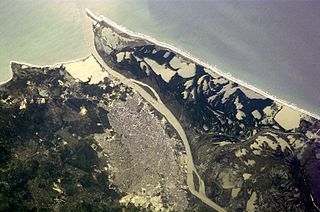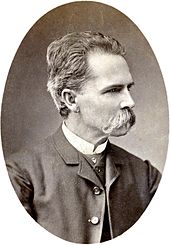
Chile's 2017 census reported a population of 17,574,003 people. Its rate of population growth has been decreasing since 1990, due to a declining birth rate. By 2050 the population is expected to reach approximately 20.2 million people, at which point it is projected to either stagnate or begin declining. About 85% of the country's population lives in urban areas, with 40% living in Greater Santiago alone. The largest agglomerations according to the 2002 census are Greater Santiago with 5.6 million people, Greater Concepción with 861,000 and Greater Valparaíso with 824,000.
White is a racialized classification of people generally used for those of mostly European ancestry. It is also a skin color specifier, although the definition can vary depending on context, nationality, ethnicity and point of view.
Latin Americans are the citizens of Latin American countries.

Asian Argentines, are Argentine citizens or residents of Asian ancestry. The vast majority trace their ancestry to West Asia, primarily Lebanon and Syria, and East Asia, namely China and Japan. Though there are other communities of South Asian or Southeast Asian origin as well. Asian-Argentines settled in Argentina in large numbers during several waves of immigration in the twentieth century.

Colombians are people identified with the country of Colombia. This connection may be residential, legal, historical or cultural. For most Colombians, several of these connections exist and are collectively the source of their being Colombian.
White Latin Americans or European Latin Americans are Latin Americans of European descent.

Chileans are an ethnic group and nation native to the country of Chile and its neighboring insular territories. Most Chileans share a common culture, history, ancestry and language. The overwhelming majority of Chileans are the product of varying degrees of admixture between European ethnic groups with peoples indigenous to Chile's modern territory. Chile is a multilingual and multicultural society, but an overwhelming majority of Chileans have Spanish as their first language and either are Christians or have a Christian cultural background.

As of 2017, South America has an estimated population of 418.76 million people.
Arab Colombians refers to Arab immigrants and their descendants in the Republic of Colombia. Most of the migrants came from Lebanon, Jordan, Syria and Palestine. When they were first processed in the ports of Colombia, they were classified as Turks because what is now Lebanon, Syria, Jordan and Palestine were then territories of the Ottoman Empire. It is estimated that Colombia has a Lebanese population of 3.2 million. Meanwhile the Palestine population is estimated between 100,000-120,000.

Immigration to Colombia during the early 19th and late 20th Century, is what makes it one of the most diverse countries in the world, above other countries in the Latin region. Colombia inherited from the Spanish Empire harsh rules against immigration, first in the Viceroyalty of New Granada and later in the Colombian Republic. The Constituent Assembly of Colombia and the subsequent reforms to the national constitution were much more open to the immigrants and the economic aperture. However naturalization of foreigners, with the exception of those children of Colombians born abroad, it is still difficult to acquire due 'Jus soli' law is not allowed by the government, and only 'Jus sanguinis' law is accepted. Immigration in Colombia is managed by the "Migración Colombia" agency.
Arab Argentine refers to Argentine citizens or residents whose ancestry traces back to various waves of immigrants, largely of Arab ethnic, cultural and linguistic heritage and/or identity originating mainly from what is now Lebanon and Syria, but also some individuals from the twenty-two countries which comprise the Arab world such as Palestine, Egypt and Morocco. Arab Argentines are one of the largest Arab diaspora groups in the world.

Venezuelans are the citizens identified with the country of Venezuela. This connection may be through citizenship, descent or cultural. For most Venezuelans, many or all of these connections exist and are the source of their Venezuelan citizenship or their bond to Venezuela.

The demographics of Colombia consist of statistics regarding Colombians' health, economic status, religious affiliations, ethnicity, population density, and other aspects of the population. Colombia is the second-most populous country in South America after Brazil, and the third-most populous in Latin America, after Brazil and Mexico.

Argentines are the people identified with the country of Argentina. This connection may be residential, legal, historical or cultural. For most Argentines, several of these connections exist and are collectively the source of their being Argentine. In the past the National Gentilic for Citizens of Argentina was mistakenly translated as Argentinians, a term that is no longer considered accurate.

Bolivians are people identified with the country of Bolivia. This connection may be residential, legal, historical or cultural. For most Bolivians, several of these connections exist and are collectively the source of their being Bolivian.
Race and ethnicity in Colombia descend mainly from three racial groups—Europeans, Amerindians, and Africans—that have mixed throughout the last 500 years of the country's history. Some demographers describe Colombia as one of the most ethnically diverse countries in the Western Hemisphere and in the World, with 900 different ethnic groups. Most Colombians identify themselves and others according to ancestry, physical appearance, and sociocultural status. Social relations reflect the importance attached to certain characteristics associated with a given racial group. Although these characteristics no longer accurately differentiate social categories, they still contribute to one's rank in the social hierarchy. A study from Rojas et al involving 15 departments determined that the average Colombian has a mixture of 48.8% Amerindian 40.2% European, and 11% African. These proportions also vary widely among ethnicities.

Mestizo Colombians refers to Colombians who are of European and Amerindian ancestry.

Immigration to Uruguay began in several millennia BCE with the arrival of different populations from Asia to the Americas through Beringia, according to the most accepted theories, and were slowly populating the Americas. The most recent waves of immigrants started with the arrival of Spaniards in the 16th century, during the colonial period, to what was then known as the Banda Oriental.
German Colombians are Colombian citizens of German ancestry. They may be descendants of Germans who immigrated to Colombia from Germany or elsewhere in Europe. Most German Colombians live in the departments of Andean Region and Caribbean Region. Germans have been immigrating to Colombia since at least 16th century. During World War II, thousands of Germans fled to Colombia.
Syrian Venezuelans refers to Venezuelan citizens of Syrian origin. Syrians are the largest immigrant group of Arabic origin in Venezuela.













